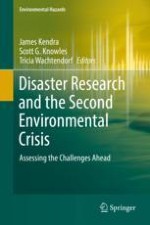2019 | OriginalPaper | Buchkapitel
Launching the DRC: Historical Context and Future Directions
verfasst von : Thomas E. Drabek
Erschienen in: Disaster Research and the Second Environmental Crisis
Aktivieren Sie unsere intelligente Suche, um passende Fachinhalte oder Patente zu finden.
Wählen Sie Textabschnitte aus um mit Künstlicher Intelligenz passenden Patente zu finden. powered by
Markieren Sie Textabschnitte, um KI-gestützt weitere passende Inhalte zu finden. powered by
